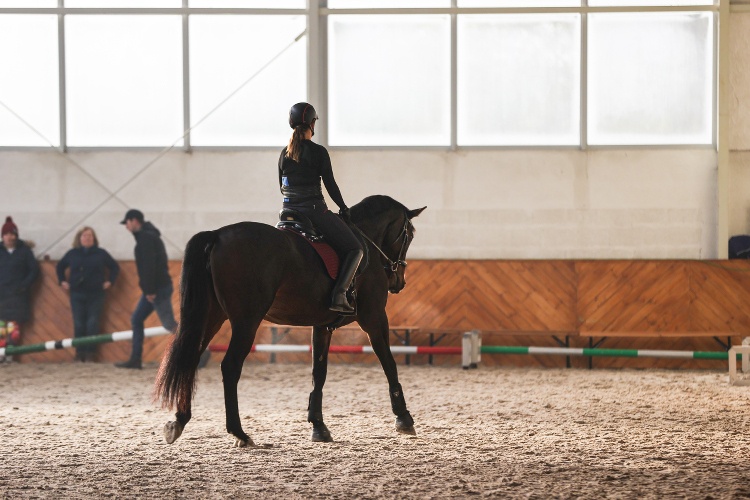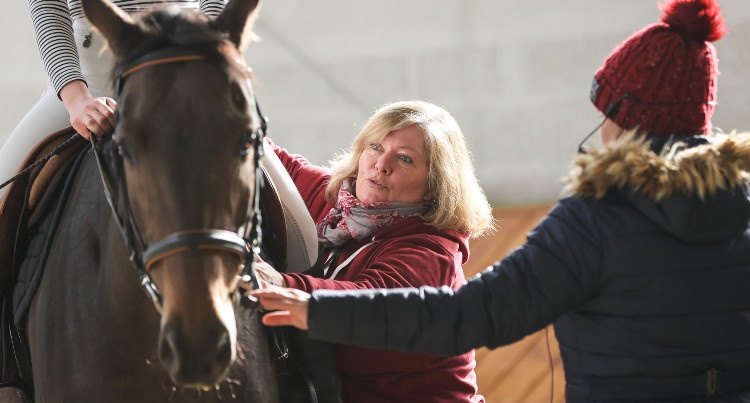
Jej metoda Rider Ability podbija serca kolejnych jeźdźców z niemal całego świata, ponieważ dzięki niej osiągają upragnioną harmonię, balans oraz zdecydowanie lepszą, bardziej świadomą, współpracę z koniem. Swoją rozległą wiedzą dzieli się już od kilkunastu lat, a prowadzone przez nią kliniki zawsze wzbudzają ogromne zainteresowanie wśród jeźdźców, co jest efektem jej charakterystycznego podejścia do uczestników, tzn. przekazywania nowych treści w przystępny sposób oraz troszczenia się o każdego jeźdźca i konia. Oczywiście mowa o Elaine Butler, która całkiem niedawno przyjechała do podkrakowskiego ośrodka Sentio Equestrian (1a 32-090 Trątnowice), by przeprowadzić kilka zaplanowanych szkoleń. Jak tak dokładnie wyglądają warsztaty z tą znaną ekspertką w zakresie biomechaniki? Czego można się spodziewać? Elaine Butler opowiedziała o tym wszystkim w poniższym wywiadzie, który przeprowadziła Olga Kulesza. 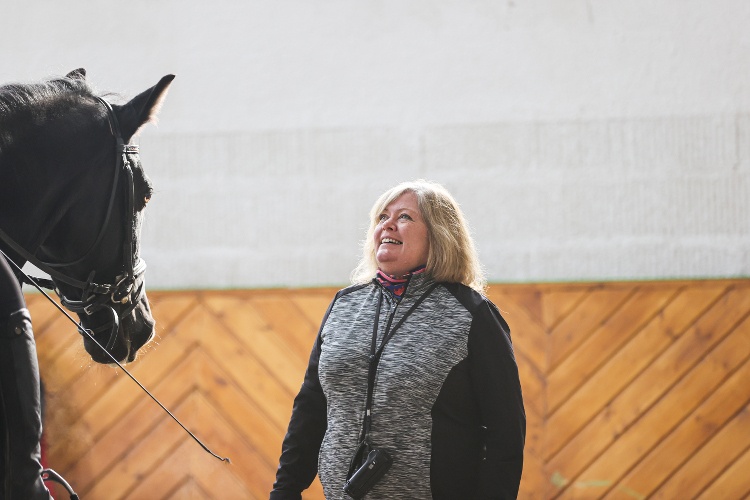
Olga Kulesza: Hello, my name is Olga Kulesza, I’ve been a veterinarian for 17 years already. I’m running my holistic practice and in about 2005, I guess, I met Elaine Butler, and she’s a big part of the things that I’m doing now, because I’ve found that the rider is the most important puzzle in the game to have the horse healthy, well behaved and performing best as he can do, and as a chiropractor as well, I found that much crookedness starts with the rider, and they are the most important thing to fix, and that’s why we have been inviting Elaine for clinics in Poland already for about 15 years now, and I’d like to ask Elaine now that she explain what is her method about.
Olga Kulesza: Cześć, nazywam się Olga Kulesza, od 17 lat pracuję jako weterynarz. Prowadzę swoją holistyczną praktykę. W roku 2005 poznałam Elaine Butler i od tego czasu jest wielką częścią tego, co robię, ponieważ odkryłam, że jeździec jest kluczową częścią tego, by koń był zdrowy, grzeczny i pracował na najlepszym możliwym poziomie. Jako chiropraktyczka teraz wiem, że wiele skrzywień rozpoczyna się od jeźdźca, najważniejsze jest to, by ich naprawić, dlatego od 15 lat zapraszamy Elaine na kliniki do Polski. Chciałabym poprosić Elaine, żeby opowiedziała nam, na czym polega jej metoda. 
Elaine Butler: Hi, I’m Elaine from RideAbility. I started working with this method about 25 years ago and I found that it is incredibly effective at putting horses and riders in balance, to provide better communication, more harmony, and also better performance for those riders that wish to take part in competitions ports. But it doesn’t matter whether it’s a leisure rider, somebody who wants to ride for fun, and whether they are competing or riding in dressage, jumping, eventing – it doesn’t make a difference because what we work on are the fundamentals. We work on how can we make the horse work better from the hind legs, how can we make the horse’s back nice and round and swinging, and to make an all-round straighter horse, so that the horse is not overloading any of his legs, not getting any injuries, and that the rider is able to balance more correctly in all three gaits: walk, trot and canter. We work a lot on trying to find the weaknesses in the horse’s movement and the rider’s movement so, for example, if you have a rider who has very weak right leg, I will sometimes use a kind of a method of putting a band around the leg in order to stabilize it. We work with some belts, so that the rider can feel the core muscles in the body working. I may use some method to stabilize the hands, so that the hands are not jumping, and I have a whole kind of kit, a pandora’s box of these toys that I use with the rider, and this helps the rider to be more conscious of the body, to control the body and to be able to move something better, for example if the hips are blocked, to move the hips better, or if something is moving too much, for example the lower leg, to stabilize. And then you find that the horses are not becoming nervous because the wrong signals are being given, and the horses are then much calmer and much more willing to cooperate with the rider.
Elaine Butler: Cześć, jestem Elaine z RideAbility. Zaczęłam pracować nad tą metodą około 25 lat temu i odkryłam, że jest niezwykle efektywna w doprowadzaniu koni i jeźdźców do balansu, by zapewnić lepszą komunikację, więcej harmonii, a także lepsze wyniki dla tych jeźdźców, którzy chcą brać udział w zawodach. Jednak nieważne, czy chodzi o jeźdźca-amatora, kogoś, kto chce jeździć dla przyjemności, czy kogoś, kto startuje w ujeżdżeniu, skokach czy WKKW – nie ma różnicy, ponieważ pracujemy nad rzeczami fundamentalnymi. Pracujemy nad tym, jak możemy sprawić, by koń lepiej pracował zadnimi nogami, by jego grzbiet był okrągły i nad tym, by uzyskać konia bardziej wyprostowanego, tak aby nie obciążał nadmiernie żadnej nogi, nie doznawał kontuzji, żeby jeździec mógł złapać poprawny balans w trzech chodach: stępie, kłusie i galopie. Staramy się znaleźć słabości u jeźdźca, więc na przykład, jeżeli mamy jeźdźca ze słabą prawą nogą, czasem używam taśm, by ją ustabilizować. Pracujemy też z różnymi pasami, by jeździec mógł poczuć pracę mięśni całego tułowia. Czasem stosuję jakąś metodę, by ustabilizować dłonie, aby nie były „skaczące”, mam do tego cały zestaw, „puszkę Pandory” tych zabawek, których używam z jeźdźcami, to pomaga im być bardziej świadomymi swojego ciała, kontrolować je i poprawiać jego użycie. Na przykład, jeżeli zablokowane są biodra, pracujemy, by lepiej ich używać, a jeżeli coś rusza się nadmiernie, na przykład dolna część nogi, stabilizujemy ją. Później okazuje się, że konie nie stają się nerwowe, bo dostarczane są im złe sygnały, konie są dużo spokojniejsze i chętniejsze do współpracy z jeźdźcem. 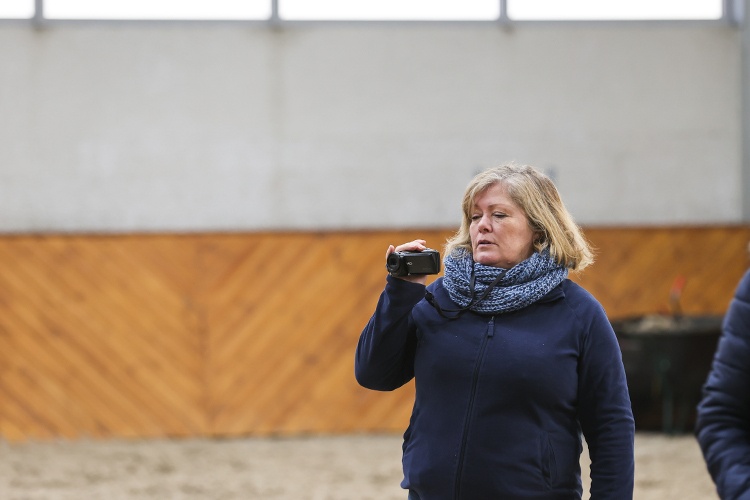
Olga Kulesza: And from my point of view that’s very important because as a vet and chiropractor I found that so many problems came back after the treatment in some time, and most of the time it’s still the same problems coming back, so if we don’t fix the rider, it can’t be any better, and during the time when the one side of the horse is being overloaded, it can cause lameness and some stiffness and it was a bit frustrating for me that those problems were coming back. So that’s why I asked my clients, my riders, owners of horses which I take care of, to come to the clinics to understand how much of an impact their seat has on their horses. I’m very happy that we are here, and we can introduce this method in such a place like Kraków – you have many riders here, and many horses, on different levels. This is really my point of view that everything really matters, the horse, the saddle, the hooves, and the rider should know that they have the biggest impact on the horse’s health, and without those changes which Elaine is telling them, what they should change, it wouldn’t work. All these things, they have the same priority in order to keep the horse light and to keep the horse fit and it doesn’t matter, as Elaine said, if they are leisure riders or they want to compete: the horse is the same, it doesn’t matter which breed, if they are stabled or if they work outside, if they are hacking – all these rules apply to them as well.
Olga Kulesza: Z mojego punktu widzenia to bardzo ważne, ponieważ jako weterynarz i chiropraktyk widzę, że wiele problemów powraca po jakimś czasie po leczeniu i w większości są to te same problemy. Jeżeli nie naprawimy jeźdźca, nie otrzymamy poprawy, kiedy jedna ze stron konia jest przeciążana, powoduje to kulawizny i sztywność, to dla mnie trochę frustrujące, że te problemy wciąż powracają. Dlatego proszę moich klientów, jeźdźców i właścicieli koni, którymi się opiekuję, o wybranie się na klinikę, by zrozumieć, jak duży wpływ ma na konie ich dosiad. Cieszę się, że tu jesteśmy i że mogę wprowadzić te metody w takim miejscu jak Kraków – jest tu wielu jeźdźców i koni na różnym poziomie. Według mnie wszystko ma znaczenie – koń, siodło, kopyta – jeździec powinien wiedzieć, że to on ma największy wpływ na zdrowie konia i bez zmian, o których mówi Elaine, to nie zadziała. Wszystkie te rzeczy mają ten sam priorytet przy utrzymaniu konia lekkim i w dobrej formie, i nieważne, tak jak mówi Elaine, czy są to jeźdźcy rekreacyjni czy startujący: koń jest taki sam, nieważne jakiej rasy, czy stoi w stajni, czy pracuje na dworze, chodzi w teren – wszystkie zasady odnoszą się także do nich. 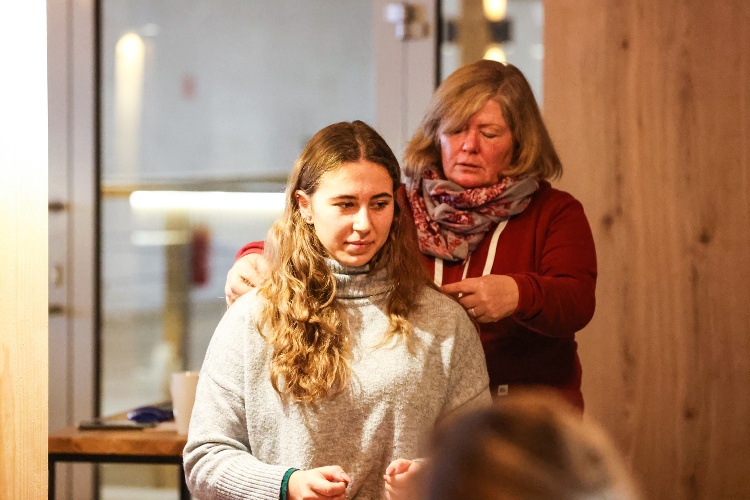
Elaine Butler: And also, it’s interesting that beginner riders and very advanced riders all have the same problems. They just come out in a different performance level. But the problems are basically just four: they either can’t go faster when they want to or increase energy, they can’t go slower or hold energy, they can’t turn left or make the horse go correctly to the left, or they cannot ask the horse to go to the right. And the problems that are causing this in the rider are often that we are asymmetric, we have a basic crookedness which stops us from being equal: equally strong and equally flexible. The horses have the same, and so we spend a lot of time trying to find how can we straighten the rider in order to straighten the horse. This makes the steering, the turning left and right much better. And also, a lot of riders are not conscious that they’re actually holding energy backwards or their weight is too far back, which is then blocking the hind legs of the horse. Or their weight is too far forward, or their energy is too far forward, and they’re blocking the front legs of the horse. And that creates problems in the speed control. So in addition to the practical work, where the riders have a private lesson, which is also videoed, we have a workshop after the ride, where the rider can view their video, and I will take a step-by-step slow-motion approach to showing exactly what is going on within each movement, and they see the changes, so they see what’s happening before we make a transformation in their body and what happens in their body but also in the horse after the transformation. In addition to that, I do a kind of a lecture about balance, and we also use physio balls and exercises on the yoga mat in order for that rider to know what to work on at home, so they get a complete package of the video, the checklist of what they need to work on, the exercises, and they kind of get a see-it and feel-it experience.
Elaine Butler: To ciekawe, że zarówno początkujący, jak i zaawansowani jeźdźcy mają te same problemy. One po prostu „wychodzą” na innym poziomie. Ale problemy są właściwie tylko cztery: albo nie mogą jechać szybciej, gdy chcą – lub podnieść poziomu energii, albo nie mogą być wolniejsi – wstrzymać energię, albo nie mogą skręcić w lewo lub sprawić, że koń poprawnie skręci w lewo, albo nie mogą poprawnie poprosić konia, by skręcił w prawo. To problemy, które sprawiają jeźdźcy przez to, że często są asymetryczni – mamy swego rodzaju skrzywienia, które nie pozwalają nam być po równo silnymi i po równo wygimnastykowanymi. U koni jest tak samo, więc spędzamy dużo czasu na to, by dowiedzieć się jak możemy wyprostować jeźdźca, aby dalej wyprostować konia. To polepsza sterowanie, zakręty. Dodatkowo wielu jeźdźców nie zdaje sobie sprawy z tego, że wstrzymują energię, że ich ciężar jest przesunięty do tyłu, co dalej blokuje tylne nogi konia. Czasem ich ciężar spoczywa zbyt daleko do przodu, co blokuje przednie nogi konia. To stwarza problemy w kontroli nad prędkością. Oprócz pracy praktycznej, gdzie jeźdźcy biorą udział w prywatnej lekcji, która jest nagrywana, mamy warsztaty po jeździe, gdzie uczestnicy mogą obejrzeć swoje nagrania, a ja pokazuję i opowiadam krok po kroku, co dokładnie dzieje się w każdym ruchu, wtedy widzą zmiany, widzą dokładnie, co dzieje się przed transformacją z ich ciałem, co dzieje się w ich ciele oraz w ciele konia po transformacji. Dodatkowo przedstawiam wykład na temat równowagi, używamy również piłek gimnastycznych i ćwiczeń na macie do jogi, żeby jeźdźcy wiedzieli później nad czym mają pracować w domu. Dostają więc pełny pakiet: wideo, listę rzeczy, nad którymi muszą się skupić oraz ćwiczenia – dostarczamy naoczne i namacalne doświadczenie. 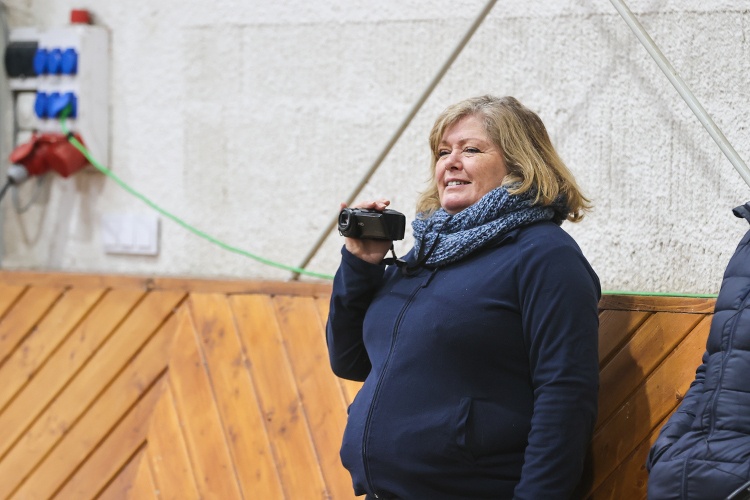
Olga Kulesza: And also, they can see on the video how the horse behaves, and, for example, which leg is overused, and then some of them just get back to the past that the horse probably had the injury because of the way they were riding, so they can still improve that. And I’m very happy that we have really different kinds of riders, we had eventers, we had jumpers, even Grand Prix level, and dressage riders as well as beginners, and just like Elaine said – all of them have the same problems, so some people are a bit afraid to come and take part in the clinic because they say “oh, I’m just a beginner”. Sometimes it’s even easier, because they don’t have such many habits they get during the years of riding, so we really welcome riders and owners at every level of education to come and take part in the clinic and do something good for their horses.
It’s the first time we’re here in Sentio Equestrian Centre, which we’ve found is a really, really good place for horses as well for the riders, there are very good conditions to have a clinic and for the workshop, so horses can go out on the paddocks and use the walking machine, so they can be fit and happy in this place. I don’t know how Elaine found this place among others, because she is giving clinics all around the world, so in comparison to other places she’s been to.
Olga Kulesza: Dodatkowo mogą zobaczyć na filmie, jak reaguje koń, która noga jest przeciążona, wtedy wracają myślami w przeszłość i odkrywają, że koń prawdopodobnie doznał urazu przez sposób jazdy, więc mogą to poprawić. Cieszę się, że przyjeżdżają do nas różni jeźdźcy, mamy WKKW-istów, skoczków, nawet na poziomie Grand Prix, zawodników ujeżdżenia i początkujących. Tak jak mówiła Elaine – wszyscy mają te same problemy, niektórzy trochę boją się przyjechać i wziąć udział w klinice, ponieważ myślą: „Och, jestem tylko początkujący”. Czasem wtedy jest nawet łatwiej, ponieważ nie mają tylu nawyków po latach jazdy. Bardzo zachęcamy jeźdźców i właścicieli koni na każdym poziomie do wzięcia udziału w klinice i zrobienia czegoś dobrego dla swoich koni.
W Sentio Equestrian Centre jesteśmy po raz pierwszy, to naprawdę bardzo dobre miejsce dla koni i jeźdźców, ze świetnymi warunkami do organizowania szkoleń i warsztatów. Konie mogą spędzać czas na padokach i korzystać z karuzeli, mogą tu być szczęśliwe i w dobrej formie. Nie wiem, jak odbiera to Elaine, bo ona jeździ na szkolenia do wielu miejsc świata, nie wiem, jak ona porównuje to na tle innych miejsc, które odwiedziła. 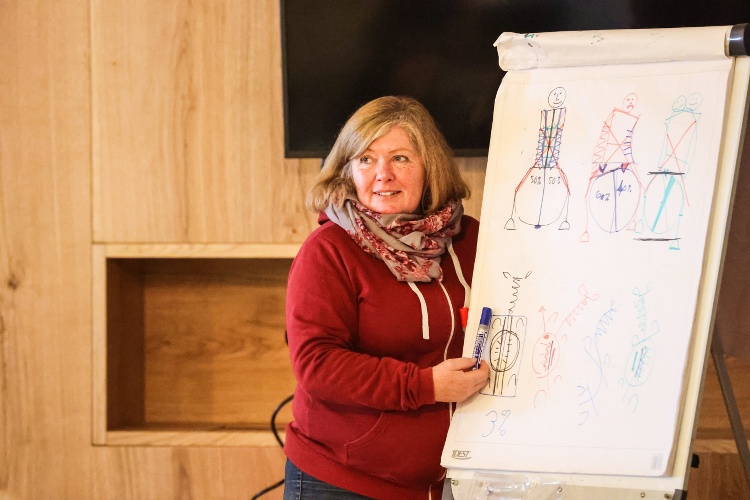
Elaine Butler: Yes, very, very lovely arena, very nice working conditions, very beautiful, very stylish as well, and a very friendly atmosphere. Everybody’s been great, good great team.
We are very happy that we can be here and hopefully we will come back
And hopefully see you next time!
Elaine Butler: Bardzo, bardzo dobra arena, bardzo dobre warunki do pracy, jest bardzo pięknie, a także stylowo, a atmosfera jest bardzo przyjazna. Wszyscy byli świetni i jest tu dobra, zgrana drużyna.
Cieszymy się, że możemy tu być i mamy nadzieję, że tu wrócimy.
Mam nadzieję, że do zobaczenia kolejnym razem!